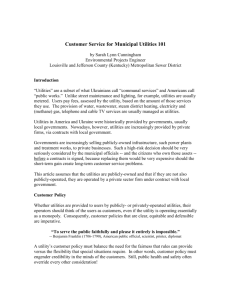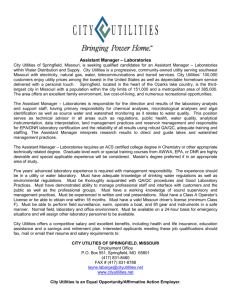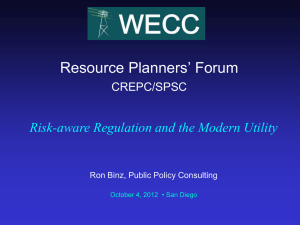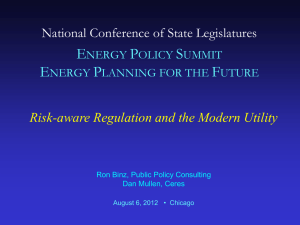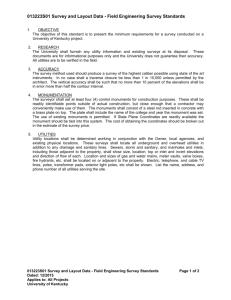Implications of Climate Change for Urban Water Utilities
advertisement
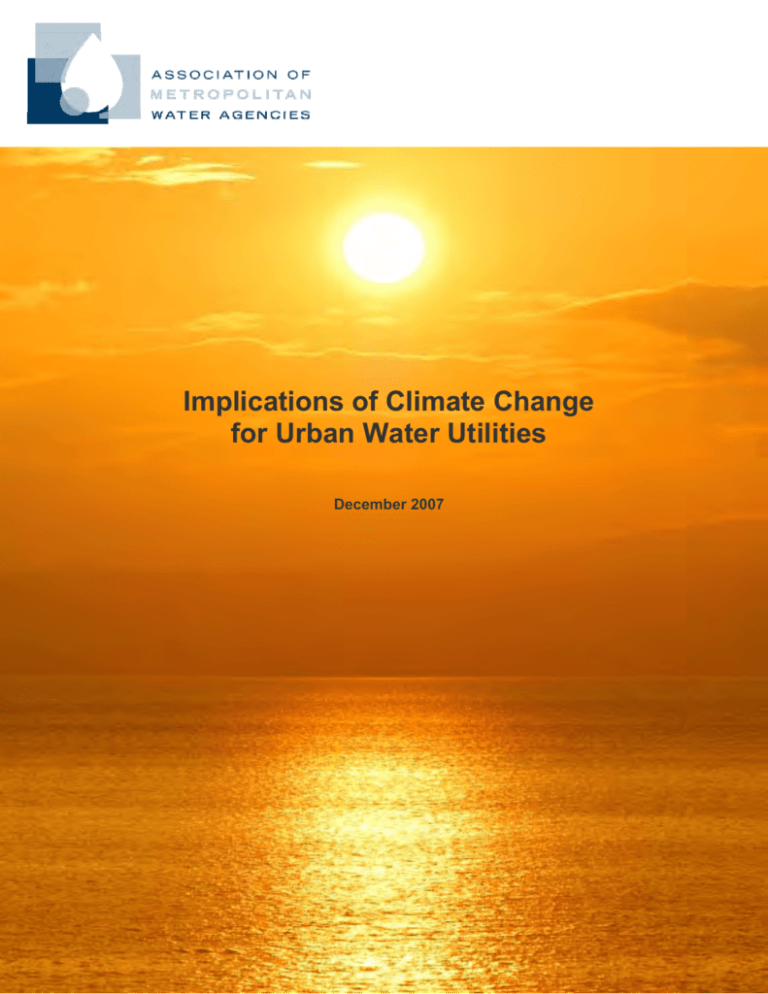
Implications of Climate Change for Urban Water Utilities December 2007 Implications of Climate Change for Urban Water Utilities Prepared by: John E. Cromwell, Joel B. Smith, and Robert S. Raucher, PhD Stratus Consulting Inc. Washington, D.C. and Boulder, Colo. Prepared for: Association of Metropolitan Water Agencies Washington, D.C. www.amwa.net Copyright © 2007 AMWA The Association of Metropolitan Water Agencies is a nonprofit organization of the largest publicly owned drinking water systems in the United States. Member-utilities collectively serve more than 127 million people with safe drinking water. Implications of Climate Change for Urban Water Utilities 1. INTRODUCTION There are many parts to the climate change story that come together to produce a picture of potentially significant implications for urban water utilities. This can create an information overload that, coupled with uncertainties, presents a barrier to understanding and to developing responses. This paper is designed to help move past this initial barrier in order to draw an effective focus on implications and responses. The story is broken into its main elements and considered in logical sequence without tangential details that are documented sufficiently in the scientific literature. The intent is to provide an essential understanding and then turn to consideration of the issues involved in developing suitable water sector responses to climate change. A general description of climate change processes and effects follows the introduction. Impacts of these climatic changes on water suppliers are then identified and described, including regional differences. Responses to climate change are then discussed, both in terms of “adaptation strategies” to reduce or avoid impacts of climate change, and in terms of “mitigation strategies” that utilities may adopt to reduce the contribution of water utility operations to the production of greenhouse gas (GHG) emissions. 2. CLIMATE CHANGE PROCESSES The understanding of climate change processes is supported by extensive scientific consensus that has been growing continually over the last twenty years and which will not be repeated here. This consensus has been led by the Intergovernmental Panel on Climate Change (IPCC), which was recently awarded a share of the Nobel Peace Prize for its efforts. The role of the IPCC, which involves thousands of scientists from around the world, is to assess the science of humaninduced climate change, mainly on the basis of peer reviewed and published scientific/technical literature. In 2006, the National Center for Atmospheric Research (NCAR) produced a primer on climate change for the American Water Works Association Research Foundation (AwwaRF) that provides a comprehensive overview of the current science supporting the understanding of climate change processes and effects. It builds on the consensus findings of the Third Assessment Report of the IPCC, published in 2001, and closely matches findings of the Fourth Assessment Report of the IPCC, published in 2007. 2.1 Increasing Temperature NCAR defines climate change as any persistent change in the statistical distribution of climate variables. The fundamental climate change process is global warming. Increases in carbon dioxide (CO2) and other GHGs resulting from human activities have caused a radiative heating Association of Metropolitan Water Agencies 1 Implications of Climate Change for Urban Water Utilities effect that traps solar energy in the atmosphere that would otherwise be dissipated back into space. This has contributed to an increase of about 0.74°C (1.3°F) in global average temperature since 1900. There is a consensus that GHGs produced by human activities have already caused an increase in global mean temperature. This trend is expected to accelerate as we continue to add GHGs to the atmosphere. By 2100, the additional rise in global average temperature is projected to be in a range of 1.1 to 6.6°C (~ 2 to 12°F) above 1990 levels. There is little doubt that this climate change process will continue to cause such warming for a long period into the future, even if it were possible to suddenly and drastically reduce GHGs. The range in estimates of the degree of warming that will occur between now and 2100 reflects the developmental state of the art of modeling global climate processes. Two factors stand out. One is that there is uncertainty about how much warming will happen with a given concentration of GHGs. For example, the IPCC concluded that there is a two-thirds chance that global temperatures will rise 2 to 4.5°C with a doubling of CO2 levels in the atmosphere. That means there is a one-third chance the warming could be lower or higher than that range. A totally different source of uncertainty is introduced by the fact that modeling the climate in 2100 requires input assumptions regarding the rate of growth of GHG emissions. These reflect uncertainties about future development paths including population growth, economic growth and technological changes. It is not surprising, therefore, that climate models produce varying estimates of both CO2 concentrations and global mean temperature. However, they all confirm the warming trend and predict it will accelerate within the next few decades. 2.2 Increasing Evaporation and Precipitation One of the simplest ways to envision the effect of global warming on water resources is to follow the logic of what happens when water is heated; global warming will basically accelerate the pace of the hydrologic cycle. Warmer temperatures will cause water to evaporate more readily and cause the total amount of precipitation to increase at a global level. This accelerated hydrologic cycle is logically projected to result in an overall increased intensity of rainfall events. Consistent with the fact that global warming has already been occurring during the last century, streamflow records already document this increase in storm intensity. In contrast to these consistent predictions of the effect of warming on the total amount of precipitation globally, forecasts of the amount of precipitation vary greatly from one region to another. Areas in the high latitudes and some wet tropics are generally expected to see increased precipitation, while dry regions in the mid-latitudes and the dry tropics are generally expected to see decreases in total precipitation. Climate models exhibit the least consistency with one another in predicting precipitation at a regional level; especially in the mid-latitudes. Association of Metropolitan Water Agencies 2 Implications of Climate Change for Urban Water Utilities At one extreme, warmer temperatures imply that areas subject to drought may see more extensive drought and heat wave events while, at the other extreme, areas accustomed to snowfall will see warmer winters. Warmer and shorter winters are already implicated in the reduction in the amount of water stored as ice in glaciers, and in seasonal snowpacks. The shorter cold season means that the spring melt can arrive much earlier and have significant implications for streamflows available downstream in late summer and early fall. 2.3 Rising Sea Level With warmer temperatures, the oceans expand (because water expands in volume when heated) and glaciers and ice sheets melt, causing sea level to rise. Sea level is projected by the IPCC to rise from 0.2 to 0.6 meters by 2100. This assumes no catastrophic losses of either the Greenland or Antarctic ice caps. Studies which account for such melting find that rates of sea level rise could be well above one meter by 2100. The IPCC itself notes that it is difficult to project an upper bound for sea level rise. 3. IMPACTS ON WATER SUPPLIERS It is important to make a distinction between the processes of climate change and the impacts on water suppliers resulting from these changes. Although global warming is fairly straightforward, the impacts on water suppliers may involve many additional cause and effect relationships. It has become commonplace to mix discussion of the basic processes of climate change, for which there is good evidence documenting changes already underway (e.g., temperature rise), together with discussion of impacts that are more remote and uncertain in terms of both the chain of causation and timing. Weaving the story together in this way can add to information overload and leave an impression that impacts are already occurring at full strength when, in fact, their onset is still unfolding. The incidence of any given impact may come about as a threshold effect, or as a tipping point phenomenon, or as a smooth gradient, or in a number of ways. Recent extreme events such as droughts may support a belief that impacts are already upon us. While this may be the case, the worst may still be yet to come. We therefore have a need to understand much more about the cause and effect relationships that produce impacts. To emphasize these distinctions, impacts are discussed separately in this paper and further distinguished between direct impacts, indirect impacts, and compound impacts. 3.1 Direct Impacts Direct impacts are defined as resulting from the effects of climate change on water utility functions and operations. In Exhibits 1 through 4, the direct impacts on water utilities are summarized for major regional scenarios in the form of simple cause and effect outlines. Association of Metropolitan Water Agencies 3 Implications of Climate Change for Urban Water Utilities Exhibit 1 – Climate Change Impacts in the Mountain West Warmer and shorter winter seasons Increased glacial melting Decreased seasonal snowpacks More rain, more rain-on-snow, and earlier spring snowmelt — Altered recharge of groundwater aquifers — Earlier runoff into surface waters Lower summer/fall base flows in surface waters Lower summer/fall reservoir levels Warmer and potentially drier summer seasons Changes in vegetation of watershed and aquifer recharge areas — Altered recharge of groundwater aquifers — Changes in quantity and quality (e.g., TOC, alkalinity) of runoff into surface waters Increased water temperature — Increased evaporation and eutrophication in surface sources — Water treatment and distribution challenges (disinfection, byproducts, regrowth) Increased water demand — Increased irrigation demand in longer growing season — Increased urban demand with more heat waves and dry spells — Increased drawdown of local groundwater resources to meet the above More frequent and intense rainfall events Increased turbidity and sedimentation — Loss of reservoir storage Shallower, warmer water; increased evaporation and eutrophication Potential conflicts with flood control objectives — Water filtration or filtration/avoidance treatment challenges Increased risk of direct flood damage to water utility facilities Association of Metropolitan Water Agencies 4 Implications of Climate Change for Urban Water Utilities Exhibit 2 – Climate Change Impacts in the Southwest Warmer and probably drier overall with more extreme droughts and heat waves Likely reduced quantities of surface water available from local runoff Likely reduced quantities of water available to recharge groundwater aquifers Very likely increased evaporative losses in inter-basin transfers of surface waters Changes in vegetation of watershed and aquifer recharge areas — Altered recharge of groundwater aquifers — Changes in quantity and quality (e.g., TOC, alkalinity) of runoff into surface waters Increased water temperature — Increased evaporation and eutrophication in surface sources — Water treatment and distribution challenges (disinfection, byproducts, regrowth) Increased water demand — Increased irrigation demand — Increased urban demand with more heat waves and dry spells — Increased drawdown of local groundwater resources to meet the above — Increased difficulty of maintaining minimum in-stream flows in surface waters More intense rainfall events Increased turbidity and sedimentation — Loss of reservoir storage Shallower, warmer water; increased evaporation and eutrophication Potential conflicts with flood control objectives — Water filtration or filtration/avoidance treatment challenges Increased risk of direct flood damage to water utility facilities Association of Metropolitan Water Agencies 5 Implications of Climate Change for Urban Water Utilities Exhibit 3 – Climate Change Impacts in the Humid East and Midwest Warmer overall More rain with seasonal shift — More rainfall in winter and late spring — Potentially less rainfall in late summer and fall with more extreme droughts Lower summer/fall base flows in surface waters Lower summer/fall reservoir levels Changes in vegetation of watershed and aquifer recharge areas — Altered recharge of groundwater aquifers — Changes in quantity and quality (e.g., TOC, alkalinity) of runoff into surface waters Increased water temperature — Increased evaporation and eutrophication in surface sources — Water treatment and distribution challenges (disinfection, byproducts, regrowth) Increased water demand — Possible increased urban demand during drought periods More intense rainfall events Increased turbidity and sedimentation — Loss of reservoir storage Shallower, warmer water; increased evaporation and eutrophication Potential conflicts with flood control objectives — Water filtration or filtration/avoidance treatment challenges Increased risk of direct flood damage to water utility facilities Association of Metropolitan Water Agencies 6 Implications of Climate Change for Urban Water Utilities Exhibit 4 – Climate Change Impacts in Coastal Regions Rising Sea Levels Increased saline intrusion into groundwater aquifers — Water treatment challenges: increased bromide; need for desalination Increased salinity of brackish surface water sources — Water treatment challenges: increased bromide; need for desalination Increased risk of direct storm and flood damage to water utility facilities Warmer overall Changes in discharge characteristics of major rivers due to upstream changes Changes in recharge characteristics of major groundwater aquifers due to upstream changes Increased water temperature — Increased evaporation and eutrophication in surface sources — Water treatment and distribution challenges (disinfection, byproducts, regrowth) Possible increased water demand — Increased irrigation demand — Increased urban demand with more heat waves and dry spells — Increased drawdown of local groundwater resources to meet the above More intense rainfall events Increased turbidity and sedimentation — Loss of reservoir storage Shallower, warmer water; increased evaporation and eutrophication Potential conflicts with flood control objectives — Water filtration or filtration/avoidance treatment challenges Increased risk of direct flood damage to water utility facilities Association of Metropolitan Water Agencies 7 Implications of Climate Change for Urban Water Utilities These cause-effect outlines illustrate the possible direct implications of climate change for utilities in the Mountain West, the Southwest, the humid East/Midwest, and in coastal areas. A number of similarities are evident across regions, but there are distinct differences also. In addition, the coastal checklist could be merged with any of the others wherever larger regions encompass both types of conditions. The impacts indicated on these outlines are not expected to emerge all together or at once. As discussed above, there are gradient functions, threshold effects, and conceivably many other influences involved in the chain of causation that will stretch impacts over time. With many climate scientists predicting an accelerating pace of change over the next several decades, these prospective impacts have meaning for today’s mid-to-long term (20-50 year) planning. We have every reason to believe these impacts are coming toward us. But utility planners will have to grapple with many of them prospectively rather than as phenomena that are already observable, except at the leading edge of the trend. These cause-effect outlines make it possible to scan the full spectrum of potential direct impacts in a one-page summary for each regional scenario that follows a simple logic and organizes the impacts into related groupings. Taken together, it is believed that these four outlines provide complete coverage of direct impacts. Despite some common elements between them, it is also believed that these four constitute the minimum set needed to cover all the direct impacts. This first iteration of these impact outlines is regarded as a work-in-progress and refinements are invited to help improve it. 3.2 Indirect Impacts Indirect impacts are defined as resulting from the effects of climate change on the baseline environment in which water utility functions and operations are carried out. In short, this distinction emphasizes the fact that the baseline operating environment is also changing. Our understanding of the impacts of climate change and our responses must incorporate this critical dimension. There are at least three major categories of indirect impacts on water supply utilities that could result from the impacts of climate change on environmental and socioeconomic systems. Although these impacts are indirect, they are nonetheless profound and deserve as much attention as the direct impacts. In fact, there are some instances where indirect impacts may be more significant than the direct impacts. Unlike the direct impacts, the main categories of indirect impacts apply uniformly through all regions of the country. Association of Metropolitan Water Agencies 8 Implications of Climate Change for Urban Water Utilities 3.2.1 Baseline impacts on terrestrial and aquatic ecosystems. Changes in basic climate variables such as temperature, rainfall, seasonal patterns, runoff characteristics and recharge patterns of both ground and surface waters can produce significant baseline changes in both terrestrial and aquatic ecosystems. Changes in the vegetative composition of terrestrial ecosystems can change the baseline geophysical and chemical character of watershed runoff and of waters recharging groundwater aquifers. The character of clay and silt particles comprising turbidity could be changed by changed runoff patterns. The chemical composition of the total organic carbon (TOC) yielded by a source water could be changed by the change in vegetative species composition. In drier conditions, wild fires are a well-known menace to surface water treatment that could become more prevalent. Pest infestations and other changes in the species composition of terrestrial ecosystems that are unfavorable to water harvesting could also emerge. Baseline changes in aquatic ecosystems could change the survivability and critical habitat requirements of threatened aquatic species. There are many situations across the country where in-stream flow requirements have been, or are being, negotiated to provide sufficient cold water to sustain fish species during summer/drought periods. In estuarine settings, the goal is to provide critical levels of freshwater inflow to maintain tolerable salinity levels during summer/drought periods. 3.2.2 Baseline impacts on water pollution. Increased frequency and intensity of rainfall is one of the most immediate effects of global warming that is already apparent in streamflow records from the last several decades. The expectation is that more severe storms will produce more severe flooding. This will inevitably result in additional water pollution from a large variety of sources. Chief among these are wastewater treatment, storage, and conveyance systems. Preliminary work by EPA has confirmed that, for the most part, wastewater treatment plants and combined sewer overflow control programs have been designed on the basis of the historic hydrologic record, taking no account of prospective changes in flow conditions due to climate change. As a result, it is conceivable that water suppliers will face a continually increased influent challenge from sewage overflows producing high concentrations of Giardia, Cryptosporidium and coliforms. 3.2.3 Baseline impacts on socioeconomic systems. Regardless of whether the water and wastewater utilities are separate organizations or combined as a single organization, their fates are always closely tied together by the water bill because affordability is indifferent to organizational distinctions. Threats to the cost-effectiveness of wastewater programs raised by climate change can have consequences for the water utility because capital resources and ratepayer resources are constrained. If the wet weather programs referred to above require expensive re-sizing to manage higher flows, it may reduce influent challenges for water utilities, but will still have an impact on the water supply side of the business through this financial Association of Metropolitan Water Agencies 9 Implications of Climate Change for Urban Water Utilities connection. A different and equally worrisome set of financial threats to wastewater utilities may result from the dry weather extremes of climate change since discharge permits and waste load allocations are quite often grounded in the low flows documented in the historic hydrologic record. At a regional level, existing institutional relationships between utilities (and other agencies involved in water management) may come under stress due to climate change. Climate change may be expected to affect every organization involved in regional collaborations, but it is less likely to affect every organization in equal measure. There may be winners and losers. The winwin equation that supported the existing constellation of interests may be thrown out of balance and require adjustment to suit everyone’s interests in the new conditions. Moreover, because the baseline operating environment is changing and will continue to change in a manner that may not be linear, it may not be sufficient to simply replace old arrangements with new ones; it may be necessary to develop and apply a completely different dynamic in conceiving and managing institutional relationships. At the very highest level of abstraction, coping with climate change challenges baseline concepts of environmental quality and environmental protection. We have a well-rooted understanding of the objectives of these efforts in a static world. What are the objectives in a world where the baseline environment is changing; do we muster to fight the warming trends and preserve the status quo, or is there a need for a more dynamic approach to managing environmental quality going forward? What is sustainability in the context of a changing baseline? Devising new partnering relationships with stakeholders and regulators will be pivotal in solving this part of the problem. 3.3 Compound Impacts Not only does each individual type of direct and indirect impact exert its own effect on a utility, but the cumulative effect can amount to much more than a summation. Because many of the individual direct and indirect impacts affect the same natural systems or utility systems, the total impact can be magnified. It has more of the character of a compounding process. There are many conceivable challenges relating to water treatment, for example, that may have to be met in order to cope with alternative water sources in response to climate change. Evaluating them individually may not reveal all the issues, but looking at all of them together could indicate the need for a more extreme treatment solution (e.g., membrane treatment). Unintended side effects also result from such complex optimizations. It may not be a simple matter, for example, to distribute membrane treated water through an aged distribution system. Side effects could be manifest as health threats (e.g., efficacy of disinfection), or as destabilizing factors that could shorten the useful life of millions of dollars worth of buried assets. Association of Metropolitan Water Agencies 10 Implications of Climate Change for Urban Water Utilities 4. RESPONSES TO CLIMATE CHANGE Many water utilities have begun to respond to climate change through “adaptation” measures to modify plans and operations to minimize impacts. These adaptation efforts fall into two broad categories. The first consists of vulnerability analyses that are intended to identify the most nearterm priorities in places where impacts could be felt the soonest. The second is long-term planning, or more formally, Integrated Resource Planning (IRP) that adopts the broadest possible strategic view of how a utility can plan to cope with such systemic changes over the longer term. Both of these types of adaptation responses are discussed individually below. In addition, utilities are responding through adoption of measures to help mitigate the onset of climate change by reducing energy consumption that contributes to the production of GHGs. These efforts are also described in a final section, below. 4.1 Vulnerability Analysis Water utilities across the country have initiated research efforts to investigate their vulnerability to climate change processes. Such efforts attempt to obtain a better analytical assessment of the possibility that current water resource development and facility plans could be disrupted by nearterm (20-50 year) manifestations of climate change processes. This initial focus on vulnerability is a good means of identifying a utility’s priority issues relating to climate change and laying the groundwork for follow-up actions. Two alternative approaches to vulnerability analysis have been articulated: “top-down” and “bottom-up.” Many initial vulnerability analyses have related to water resource and facilities planning. However, direct impacts to water utility facilities from flooding due to more intense rainfall activity or sea level rise are other obvious priorities for such analysis. Some of these efforts have employed climate models (referred to as GCMs – General Circulation Models) to attempt to build climate change forecasting into the front end of water supply planning. This has been labeled the “top down” approach to vulnerability analysis. The major drawback of this approach lies in the current level of analytical resolution of the GCMs. The nearly two dozen most recognized GCMs are consistent in projecting increasing global mean temperature, but across a range of variability that is also, in part, the product of various GHG “emission scenarios” that reflect alternative global assumptions about the future path of economic growth and efficacy of GHG controls. Projected changes in precipitation are less consistent between models at a regional level. Experts in the field have developed sophisticated “downscaling” techniques to interpret GCM outputs for smaller geographic areas, but there are trade-offs involved in such procedures and the level of spatial resolution is still quite broad. Finally, the “top-down” approach is challenged by one additional source of variability in that GCM precipitation forecasts must be converted to changes in surface runoff and groundwater recharge in order to connect with water resource planning models. Association of Metropolitan Water Agencies 11 Implications of Climate Change for Urban Water Utilities The interest in GCMs by water utilities is helping to advance the state of the art in climate modeling, but there are pros and cons to consider in assessing the priority of such research. On one hand, there is probably no other way to know how much more resolution can be obtained from these tools except to keep pushing forward. On the other hand, it is not clear that the level of precision needed to connect with water resource planning models is obtainable – or necessary to plot the next steps in coping with climate change. The general findings of climate research are sufficient to trigger concerns for water supply plans on the 20-50 year horizon. How much more precision is required? If the critical threshold is not tripped in 20 years, it is more likely that it will be tripped within 30 because climate change is already “in-the-pipeline” and we know the effects will emerge and build continually. There is reason to question whether climate modeling can catch up with climate change enough to provide useful precision, but in some cases, the research insights gained from such modeling may be as, or more, useful than the predictions. In contrast, a “bottom-up” approach to vulnerability analysis has also been articulated as a recommended path for utilities to follow in investigating impacts of climate change. The central idea of this approach is that utilities can work with their own water resources planning models to assess the vulnerability of their 20-50 year supply plans to climate change. Based on the general findings of climate change research, utilities can identify the likely cause-effect pathways that could prove troublesome, such as many of those listed in Exhibits 1 through 4. A utility’s own water resource modeling tools can then be applied to examine extreme scenarios, involving such features as decreased inflow from runoff, decreased recharge, increased evaporative losses, and seasonal shifts. The “bottom-up” analysis enables a utility to test the robustness of current plans to upsets from changes in key climate-related variables. Once the thresholds or tipping points of a utility’s plans have been identified in this manner (using familiar models in which a utility has relatively good confidence), it is then possible to turn to the climate scientists and ask how plausible such breaking point scenarios seem in light of the results of broader research with the various GCMs. This is a question that can draw on all of what has been learned in climate research without being limited to one or several models and without trying to undertake new climate modeling work. There is a considerable body of climate research that has been devoted to understanding the similarities and differences between the predictions of alternative climate models, focusing on their comparative consistency and overall accuracy versus precision. This type of comparative and interpretive analysis of climate modeling across the range of GCMs may be an important research priority for water utilities, enabling continuing improvements in the “bottom-up” approach to vulnerability analysis. 4.2 Integrated Resource Planning The long-term response that is most prevalent in discussions of climate change is fortunately one that is familiar to many water utilities – IRP. A hallmark of this approach to long-term planning Association of Metropolitan Water Agencies 12 Implications of Climate Change for Urban Water Utilities is the adoption of a very broad view of the problem that “integrates” all facets of it – environmental, socioeconomic and engineering – as a basic strategy for keeping a wide range of options open and providing a maximum of flexibility. All of the advice on adaptation to climate change begins with the same message: employ a portfolio approach – maintaining a maximum degree of flexibility and resiliency. The IRP approach has been used extensively in water resource development and supply planning. It is often called Integrated Water Resources Planning, although it is sometimes undertaken without being explicitly labeled as IRP. Similar processes have also been used in regional or basin-wide studies of flood control. The continued improvement and refinement of best practice in IRP will be of significant value to water utilities in coping with climate change. An essential part of maintaining a broadly “integrated” approach is the continuous involvement of all stakeholders. IRP is most appropriate to problems of sweeping proportions that involve complex trade-offs between multiple objectives and multiple constraints. The best solutions are made possible in such situations because IRP recognizes that stakeholders have the capacity to redefine some of the objectives and constraints when necessary to avoid an impasse. But this only works if stakeholders are fully involved. The paragraphs below contrast IRP against the major impacts of climate change as a means of reviewing how well it matches up to the challenge at hand. It is plain from the sheer extensiveness of direct, indirect and compound impacts, that there may be a number of situations where negotiating marginal refinements to objectives and constraints with stakeholders could greatly ease the trade-offs otherwise involved. Partnering water and wastewater utilities within a region and regulatory agencies constitute important subgroups of stakeholders with whom it may be necessary to devise entirely new institutional structures and methods of collaborating to meet multiple objectives and constraints on a changing playing field. Such restructuring is consistent with the IRP approach of redefining objectives and constraints to broaden the boundaries and admit a broader range of solutions. Even before climate change emerged as such a dominant theme, it had been asserted that managing water resources within a basin or region to a “Triple Bottom Line” criteria (essentially containing all the same elements as “integrated” resource planning) could produce better environmental outcomes than managing to a disjointed array of standards established at national and state levels. The additional imperatives imposed by climate change may provide enough reasons to consider such innovative approaches. If programs such as those intended to control sewage overflows and waste load allocations are undermined by changes in hydrology, there may still be room to maneuver within the altered hydrologic system and attain good outcomes, if regulatory constraints are flexible. Association of Metropolitan Water Agencies 13 Implications of Climate Change for Urban Water Utilities Hydrologic changes will also change the balances between utilities within a region. There are no guarantees in the existing resource allocations. The potential for broader regional collaboration – up to and including consolidation of smaller utilities into larger entities – has often run aground because existing resource allocations create “have” versus “have-not” relationships that are difficult to convert into win-win relationships. Climate change has the potential to create situations in which no utility has a sure advantage, but in which there are clear advantages to operating at a larger regional scale to make more options available. Restructuring of regional and related institutional relationships may be an important theme in coping with climate change. The bottom line in water supply planning has always been a matter of coping with variability. With the coming changes in climate, there will be a heightened need to respond to increased variability. The net effect of the direct impacts of global warming itemized in Exhibits 1 through 4 will be to change the variability of key parameters affecting the quantity and quality of water that would normally be expected to be available at any specific time and place. In addition, the capability to store water in various forms and the demand for water will be changed. Given the sweeping extent of these changes, the IRP approach of taking the broadest possible view of the problem is indeed an ideal adaptation strategy. Working within broadly established system boundaries, it is possible to approach optimization in a manner that first derives maximum advantages from flexible operating strategies to expand the number of ways in which supplies can be managed to meet demands. This can have the benefit of deferring irreversible capital projects that may present more risk in a changing environment. Water utilities already employ sophisticated modeling tools (RIVERWARE, BASINS, OASIS, WEAP) to design such operating strategies, and it seems likely that applying such modeling tools to the design of adaptation strategies will be as, or more, important a priority as the climate models previously discussed. Significantly, the IRP approach also features comprehensive assessment of strategies that can be applied to manage the water demand side of the equation. Warming processes will lead to altered demand patterns as a result of seasonal shifts in precipitation, more evaporation, more frequent heat waves, and more extensive droughts. Conservation programs offer a bonus in reducing both water supply needs and energy use. Bolstering conservation incentives (and disincentives to outdoor water use) may become more essential if warming processes otherwise increase water demands, especially during coincident peak demand periods when both water supply and electric power capacities are stretched to their limits. 4.3 Reducing Greenhouse Gas Emissions to Help Mitigate Global Warming As has already happened in many water-short areas, it is possible to conceive of many ways to enhance the reliability of water resource management by essentially investing more energy to produce more water. But evaluation of these options must acknowledge the reality that water Association of Metropolitan Water Agencies 14 Implications of Climate Change for Urban Water Utilities utilities account for a significant share of total electric consumption and that power plant emissions account for a significant share of GHGs. Moreover, the latest report of the IPCC holds out hope that global warming can indeed be mitigated through GHG reductions. The key for water utilities will be to fully incorporate the objective of reducing GHG emissions (i.e., reducing their “carbon footprint”) as an additional objective within the IRP optimization framework. As urban areas have grown, and continue to grow in the suburbs, water resource managers have already devised elaborate portfolio strategies to tap into multiple sources of supply coupled with strategic investments in capabilities to move and store water. While this flexibility in transmission and storage will be a valuable asset in re-optimizing current schemes to meet the challenges ahead, some features of the systems designed under the current understanding of climatic variability may not be reversible, or easily adaptable, under different operating regimes that were never previously envisioned or constrained by a desire to limit production of GHGs. The rising cost of electric power has caused many water utilities to re-examine their operating strategies in transmission and distribution in search of ways to curtail electric usage during peak periods and generally conserve the use of electric power. Some cost saving strategies – such as using back-up generators to serve peak period loads (where not prohibited by air quality regulations) – may save money, but not reduce GHG emissions. On the other hand, renewable energy supply strategies such as solar or wind-powered pumping, or in-line hydro power generation, may be more expensive initially, but provide fuel cost savings and avoid GHG emissions. The challenge is to integrate such strategies within the IRP process to produce the best operating outcomes for the system as a whole in terms of cost, reliability and social/environmental consequences. For example, the reliability profile of a solar or windpowered option may be such that it is only viable if a back-up generator is available to fill critical gaps, producing some GHG emissions, but less overall than a conventional power supply strategy. Many water suppliers in over-constrained settings have also turned to energy-intensive membrane treatment processes to enable desalination of saline water sources and reuse of highly treated wastewater effluent. These processes make it possible to overcome a deterioration in the reliability of normal sources of supply by making it possible to meet part of the demand from sources that will be abundant under most climate change scenarios (i.e., yields from water reuse and desal supply options are drought-resistant). Although the cost – and especially the energy cost – of these technologies is significant, they should also be evaluated in the context of the overall IRP portfolio of options. If these technologies can plug a gap, or shore up a vulnerability produced by climate change processes, in a way that enables a broader scope for optimization across the entire portfolio, then they could play a critical role in improving the overall optimization. Association of Metropolitan Water Agencies 15 Implications of Climate Change for Urban Water Utilities 5. SUMMARY The broad range of impacts that could be produced by climate change on water suppliers is staggering. It is important to temper the understanding of these impacts with an informed sense of the pace at which climate change is becoming manifest. At the moment, the scientific consensus supports a view that: 1) global warming is already happening; 2) it is likely to accelerate over the next several decades; 3) it is possible to meaningfully mitigate it through GHG reductions; 4) it will get worse until we can stabilize the situation through mitigation. The leading edge of some types of impacts on water suppliers may be apparent today, but the larger part is yet to come, spread over the rest of the present century and continuing for centuries beyond. The relevant responses to climate change are already being adopted by many water utilities. These include: 1) vulnerability analysis to identify near-term priorities for adaptation of capital and operating plans; 2) IRP to provide a comprehensive framework within which to further study the change processes and devise a broad array of adaptive measures that can sustain water supplies despite ongoing environmental changes; and 3) GHG reductions to help mitigate the global warming process. The planning element of these response measures is especially significant. It is worth noting that climate change is not something the present generation of utility managers can solve. However, the present generation of managers can establish the right planning and related research processes needed to enable future success in coping with climate change. 6. BIBLIOGRAPHY 6.1 General Background on Climate Change and Impacts Climate Change and Water Resources: A Primer for Municipal Water Providers, K. Miller and D. Yates, National Center for Atmospheric Research (NCAR), Awwa Research Foundation Report #91120, 2006. http://www.awwarf.org/research/TopicsAndProjects/projectSnapshot.aspx?pn = 2973 Third Assessment Report, Intergovernmental Panel on Climate Change (IPCC), 2001. http://www.ipcc.ch/ Fourth Assessment Report, Intergovernmental Panel on Climate Change (IPCC), 2007. http://www.ipcc.ch/ No Doubt About Climate Change and Its Implications for Water Utilities, J. Cromwell, J. Smith and R. Raucher, Journal of the American Water Works Association, September 2007. Association of Metropolitan Water Agencies 16 Implications of Climate Change for Urban Water Utilities 6.2 Regional Patterns and Climate Modeling Climate Change and Water Resources: A Primer for Municipal Water Providers, K. Miller and D. Yates, National Center for Atmospheric Research (NCAR), Awwa Research Foundation Report #91120, 2006. http://www.awwarf.org/research/TopicsAndProjects/projectSnapshot.aspx?pn = 2973 In Hot Water: Water Management Strategies to Weather the Effects of Global Warming, B. Nelson, M. Schmitt, R. Cohen, N. Ketabi, and R. Wilkenson, Natural Resources Defense Council, July 2007. http://www.nrdc.org/globalWarming/hotwater/hotwater.pdf Climate Change and Its Implications for the Rocky Mountain Region, J. Smith and C. Wagner, Journal of the American Water Works Association, June 2006. The Sensitivity of California Water Resources to Climate Change, S. Vicuna, E. Maurer, B. Joyce, J. Dracup, and D. Purkey, Journal of the American Water Resources Association, April 2007. MAGICC/SCENGEN: User-friendly Software for GCM Inter-comparisons, Climate Scenario Development and Uncertainty Assessment, T. Wigley, National Center for Atmospheric Research, Boulder, CO., 2003. http://www.cgd.ucar.edu/cas/wigley/magicc/index.html. 6.3 Water Resources Planning Models BASINS www.epa.gov/waterscience/basins OASIS www.hdrologics.net/oasis.html RIVERWARE http://cadswes.colorado.edu/riverware/ WEAP www.weap21.org 6.4 Rainfall Intensity and Water Treatment Effect of Rainfall on Giardia and Crypto, T. Atherholt, M. LeChevallier, W. Norton, and J. Rosen. Journal of the American Water Works Association, September 1998. Association of Metropolitan Water Agencies 17 Implications of Climate Change for Urban Water Utilities Climate and Waterborne Disease Outbreaks, J. Rose, S. Daeschner, D. Easterling, F. Curriero, S. Lele, and J. Patz. Journal of the American Water Works Association, September 2000. Discussion of Climate and Waterborne Disease Outbreaks, M. Pickel, and C. Johnson. Journal of the American Water Works Association, December 2000. 6.5 Rainfall Intensity and Wastewater Issues A Screening Assessment of the Potential Impacts of Climate Change on the Costs of Implementing Water Quality-Based Effluent Limits at Publicly-Owned Treatment Works in the Great Lakes Region, U.S. Environmental Protection Agency, EPA/600/R-07/034A, September 2006. A Screening Assessment of the Potential Impacts of Climate Change on Combined Sewer Overflow (CSO) Mitigation in the Great Lakes and New England Regions, U.S. Environmental Protection Agency, EPA/600/R-07/033A, September 2006. Association of Metropolitan Water Agencies 18
